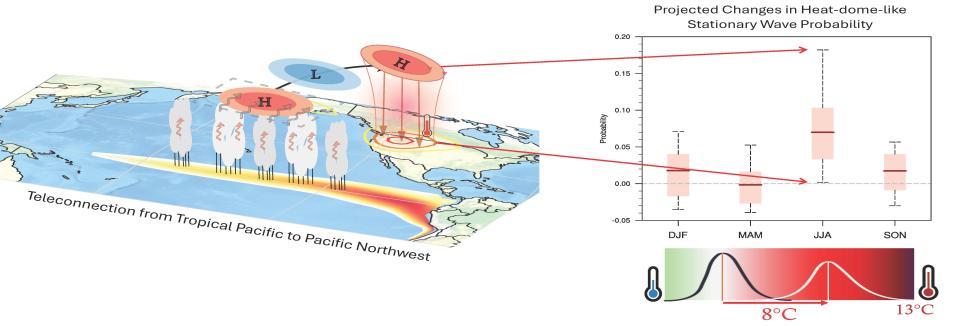WACCEM Research Areas
Variability and changes in the Earth’s water cycle have profound influences on water availability and hydrologic extremes. The Water Cycle and Climate Extremes Modeling Scientific Focus Area (WACCEM SFA) began in fiscal year (FY) 2016 with a 10-year vision to advance robust predictive understanding of water cycle processes, especially hydrologic extremes, and their variabilities and multidecadal changes. Achieving this long-term goal will strengthen our ability to inform mitigation and adaptation planning to address water and energy security challenges facing our nation and the world.
As the water cycle is strongly influenced by large-scale circulation, convection, and their multiscale interactions, WACCEM’s research is organized around three overarching science questions:
- How do large-scale circulation features, especially their dominant patterns of variability, modulate regional mean and extreme precipitation, and how will they change in the future?
- What processes control mesoscale convection and associated warm-season regional mean and extreme precipitation, and how will they change in the future?
- What are the multiscale interactions between atmospheric circulation features and water cycle processes, and how do they influence regional mean and extreme precipitation?
Building on the research in Phases 1 and 2 (FY 2016–2023), WACCEM’s Phase 3 research has a stronger focus on: (a) extreme events, which have increasingly threatened lives, properties, and water and energy security; (b) organized convection with significant implications for tropical energy balance, hydrological cycle, and global climate; and (c) surface–atmosphere interactions and their contributions to predictability of extreme events at subseasonal-to-interannual timescales.
WACCEM Research Focus Areas
-
Research Element 1: Large-Scale Circulation
-
Research Element 2: Mesoscale Convection
-
Research Area 3: Surface-Atmosphere Interactions
WACCEM is organized by three Research Element (REs), each with two Thrust areas. With a focus on the water cycle and extreme events, WACCEM is substantially contributing to DOE BER’s mission to advance fundamental research in climate sciences to support DOE’s energy, environment, and national security goals.

Research Element 1: Large-Scale Circulation
1A: Midlatitude stationary waves and extremes. Concurrent and compound extreme events have become more frequent and organized since the satellite era. How the atmospheric circulation may respond to climate change and dynamically impact regional extremes is still being debated. Aided by a new E3SM model hierarchy being developed by WACCEM and interpretable machine learning (ML) approaches, we strive to unravel the dynamical constraints behind the midlatitude summer circulation and the robust changes in the leading modes of variability.
1B: Tropical circulation and intraseasonal variability. In the tropics, the boreal summer intraseasonal oscillation (BSISO) is a dominant subseasonal mode of variability in the tropical Indian and Western Pacific regions. Possible changes in the BSISO under warming can potentially lead to life-threatening heat and deluges. Guided by the moisture mode theory and the associated conceptual framework, and leveraging the feedback denial experiments in the E3SM model hierarchy, we aim to understand the role of climate feedback on the BSISO and the mechanisms underlying future changes in the BSISO and their impacts on extreme events.

Research Element 2: Mesoscale Convection
2A: Mesoscale convective organization over tropical ocean. Tropical deep convection that organizes and grows upscale into mesoscale convective systems (MCSs) have substantial impacts on the hydrological cycle and radiation budget. Major gaps in understanding convective self-aggregation and mesoscale convective organization over the tropical oceans and the response to warming will be addressed using observations, global MCS tracking data, ML models, a kilometer-scale MCS reanalysis, and large eddy simulation (LES) modeling.
2B: Extreme mesoscale convective systems over land. In the central United States, MCSs that cluster in space and time are more effective in producing floods than individual MCSs. However, the role of clustered MCSs in producing extreme rainfall in regions other than the United States is largely unknown. Extending the WACCEM MCS datasets, tracking tools, and water tracer modeling, we will investigate the characteristics of extreme MCS precipitation over global land areas, their environments and predictability, and the role of land–atmosphere interactions.

Research Area 3: Surface-Atmosphere Interactions
3A: Local and remote land–atmosphere interactions. The societal benefits of subseasonal-to-seasonal (S2S) forecasts of extreme events have been well recognized. While progress has been made in exploiting the predictability associated with the Madden-Julian Oscillation (MJO), the role of soil moisture has not received as much attention. To understand predictability of extreme events at S2S timescale, we will investigate the predictability associated with the two-way interactions between intraseasonal signals (e.g., MJO, BSISO) and land–atmosphere interactions by using a new WACCEM-developed land-coupled data assimilation system in E3SM and other tools.
3B: Land–atmosphere–ocean interactions. Land-surface anomalies associated with intraseasonal signals can affect sea surface temperature (SST) through teleconnections. Such land–ocean teleconnections through Rossby wave propagation in the atmosphere may introduce predictability for extremes at subseasonal-to-interannual timescales, as ocean has longer memory. Such predictability will be studied using a moist linear baroclinic model and E3SM land-coupled data assimilation.
